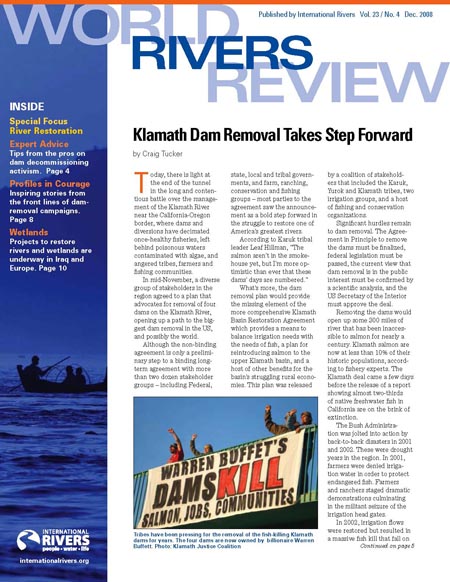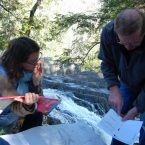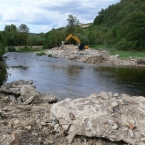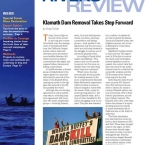Dam Removal: Learning from the Pros
 From December 2008 World Rivers Review: Special Focus on River Restoration
From December 2008 World Rivers Review: Special Focus on River Restoration We talked with some of the world's best experts and advocates for dam removal to find out what lessons they have learned on this complex topic, and what hopes they have for reviving the world's dammed rivers. Below are their answers to a few questions about what it takes to create a successful dam decommissioning campaign.
1. When approaching a dam removal project, what is the first thing you have to know, the first step, the first thing you would tackle?
Helen Sarakinos, whose group, the River Alliance of Wisconsin, has helped remove many
obsolete dams in that heavily dammed state, put it most succinctly: "Is there a local voice willing to speak for the river? If you don't have a local champion, you don't have a prayer. No one wants to hear city folks tell them what to do with their dam," she says.Craig Tucker's work on behalf of the Karuk Tribe in the very heated effort to remove four dams on the Klamath River has taught him that the more political the battle is, "the more diverse and broad a coalition you need" to win. "We have tribal leaders, scientists, farmers, and commercial fishermen working to forward our message," he notes. The Klamath coalition has had a clear plan of action for information gathering as well: "First, clearly define the ecological impacts of the project. Although to most of us it's obvious that fish need water and spawning habitat, dam removal advocates typically have to prove these points in court. Make sure your science is extensive and legally defensible. Compare the costs of dam operations to dam removal."
A number of our respondents said that the first step is find out if the dam owner will be a willing partner in a dam removal or decommissioning effort. Brian Graber, who has worked on at least 20 successful and 45 in-progress dam removal campaigns for American Rivers, said, "You can't just pick a dam and remove it. You have to have the dam owner on board. Usually it doesn't take expensive feasibility studies to assess whether a dam owner will be amenable to removal. If they need to see an expensive feasibility study, they usually aren't going to consent. Presenting a well-thought-out set of conceptual reasons, including both economic and ecological benefits to removal, is usually enough to determine if a dam owner is truly interested."
Sara Strassman, also of American Rivers, says it's not enough just to know who owns the dam: "Go see the dam, understand what it was used for and how it impacts the river dynamics and ecosystem, and to know what steps must be taken to remove the dam and who your partners might be."
2. What makes the strongest argument for dam removal?
Nearly all our respondents said that economics is the key argument. Says Brian Graber, "Dam ownership requires costly maintenance and repairs and carries liability. Dam removal is a one-time expense. In addition, there are many funding sources available for river restoration, while there are few to none available for dam repair. Considering long-term costs, dam removal will almost always be cheaper than keeping a dam." Adds American Rivers' Sara Strassman, "Why maintain something that provides no services?"
Helen Sarakinos agrees that "it almost always comes down to money. But I've also come to realize that it also comes down to someone believing in the river that could be. It's a huge leap of faith to imagine a river where a lake used to be. If someone can imagine that, and it's a more affordable solution, then dam removal can happen."
Adds Sara Strassman, "Most people will want to do something beneficial for river health if they can understand the process and if it doesn't cost them money. Dam removal, like any other social decision-making, has tensions around economics and the distribution of real and perceived gains and losses and these tensions manifest themselves differently in every case. It is important not to argue over emotional attachments to a dam."
In the case of the Klamath, it's not just the project's poor economics, but the added liability of a toxic reservoir. Says Craig Tucker, "On the Klamath, the reservoirs created by the dams erupt each summer with massive blooms of toxic blue-green algae. In addition, the Klamath dams generate little power, while bringing the facilities into compliance with modern environmental laws by building fish ladders and other modifications will cost ratepayers nearly $500 million."
3. In your campaigns, how important was it to have alternatives or replacements for what was lost in decommissioning?
Many campaigners said the dams they have worked to remove no longer provide the services they once did. "Generally, we are removing dams that have not served their original purpose for 50-100 years," says Sara Strassman. Yet even obsolete dams are not always a "slam dunk" for removal. Notes Helen Sarakinos: "In our part of the country, dams often don't provide many benefits to the communities around them. They're remnant dams, and often expensive to maintain. And yet, people keep pouring money into them. In this work, you have to understand that fear of change is a powerful motivator. People will choose the devil they know over the devil they don't."
Brian Graber told us that even when the removed dam no longer provided reliable services, "in some cases we have replaced a dam's uses during removal anyway. For example, at one site, we replaced an impoundment water supply with nearby underground tanks, which are ultimately proving to be a more reliable source of water."
Pedro Brufao of Spain's Rios Con Vida states, "Alternatives are always basic to our campaigns. Demand-side management is the best tool. Water and energy needs can be met using less electricity and water. The use of economic arguments is also a constant."
4. What are some of the most important lessons you've learned in this work?
"I learn something new on every single project," says Brian Graber. "Perhaps the best lesson is to expect that every project is going to have some unique challenge that you haven't faced before, from engineering constraints, to finding creative ways to replace dam uses, to regulatory challenges, to working on social issues. But a constant is that almost every single project is going to have some vocal opposition. You should not expect that you will be able to sway opinions despite your best public-participation efforts. It seems 10% percent of the people will always disagree with you, even on projects you would initially expect to be non-contentious. I recommend anyone in this work get training in mediation, conflict resolution and facilitation."
Laura Wildman of American Rivers says that public participation can make or break a campaign. "Don't underestimate the power of public opinion/perception. Be prepared to deal with an often-slow public education process on dam removals that catch the public eye. Often the numbers and facts alone will not convince anyone." She adds a bit of perspective to keep in mind: "the history of the river extends far beyond man's perception of history."
Pedro Brufao has learned that overcoming preconceived notions is harder than it looks. "For most of the public, there are many myths surrounding dams: dams are forever, dams are good, dams are monuments of our civilization, every dam is necessary, engineers never fail, there is no flawed dam project, dams cause no harm, rivers are just channels of water, rivers have surpluses of water, polluted rivers clean themselves, fish are less important than humans, levees provide safety from flooding. We have to reject those myths by using rational arguments such as economics and alternatives. We need a lot of patience to change minds."
Some resources, like funding, can be modified based on the objectives and the scale of the project. According to Sara Strassman, the most important resource is time, and it is finite. "Putting together a timeline for the project and its various components is a worthwhile investment because it creates the best opportunity for effective time management."
Brian Graber agrees: "Have a reasonable expectation for project timing. Dam removal projects can take a long time - we start off with the expectation that it is at least a three-year process, even for a small dam."
Laura Wildman has learned that complex technical fixes on engineered rivers aren't always the best approach. "We need to back off and give the river more room. Rivers need to move and often with river restoration less is more. We often do more bad than good when we constantly tinker with rivers."
5. Can you anticipate any repercussions for river restoration efforts from the US and global financial crisis?
Here, some see opportunities while many others see constraints in the crisis. In the "glass is half empty" camp, Craig Tucker notes that "it certainly will be more difficult to fund our campaigns and on-the-ground restoration efforts. I hope that the corollary to that is that it will be more difficult to fund new dams and diversions as well!"
Helen Sarakinos believes it could cut either way. "Cost may become an even stronger bottom line in repair-versus-removal decisions."
Sara Strassman agrees; "On one hand, funding opportunities through the traditional restoration funds may decrease as federal and state budgets and philanthropic giving retract. On the other hand, economically efficient solutions to infrastructure problems may become more attractive in an era of restricted resources. Free services provided by functioning natural environments are cheaper, and more attractive, than engineered solutions."
Pedro Brufao is not going to take this lying down, however: "Environment and human rights related to water are always put aside when crisis shows up. We've got to let the public know that river restoration is cheaper, healthier and much more profitable than the alternative of doing nothing or going forward with our mad ‘fluvicide'."
Read the full interviews with the River Restorers mentioned above, plus a few others:
Pedro Brufao
Rios con Vida (Spain)
Jim Thompson
Maryland Department of Natural Resources - Fisheries Service
Serena McClain
Associate Director, River Restoration Program, American Rivers
Helen Sarakinos
Director, River Restoration Programs, River Alliance of Wisconsin
Brian Graber
Associate Director, River Restoration Program, American Rivers
Sara Strassman
Associate Director, River Restoration Program, PA Field Office, American Rivers
Ercan Ayboga
Initiative to Keep Hasankeyf Alive (Turkey)
Laura Wildman
Chief Engineer, American Rivers
Craig Tucker
Klamath Campaign Coordinator, Karuk Tribe






